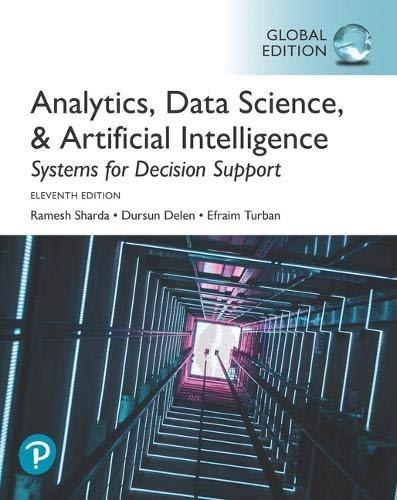XPRIZE is a nonprofit organization that allocates prizes via competitions to promote innovations that have the potential
Question:
XPRIZE is a nonprofit organization that allocates prizes via competitions to promote innovations that have the potential to change the world for the better.
The main channel for designing prizes that solve humanity's grandest challenges is called Visioneering.
It attempts to harness the power of the global crowd to develop solutions to important challenges.
The organization's major event is an annual summit meeting where prizes are designed and proposals are evaluated. The experts at XPRIZE develop concepts and turn them into incentivized competitions. Prizes are donated by leading corporations.
For example, in 2018, IBM Watson donated a
$5 million prize called "AI approaches and collaboration." The competition had 142 registered teams, and 62 were left in round 2 in June 2018. The teams are invited to create their own goals and solutions to a grand challenge.
The Problem
Every year, there is a meeting of 250 members of
"Visioneers Summit Ideation" where top experts (entrepreneurs, politicians, scientists, etc.), participate to discover and prioritize topics for the XPRIZE agenda.
Finding the top global problems can be a very complex challenge due to a large number of variables.
In just a few days, top experts need to use their collective wisdom to agree on the next year's XPRIZE top challenges. The method used to support the group's decision is a critical success factor.
The Solution
In the 2017 annual meeting for determining what challenge to use for 2018, the organization used the swarm AI platform (from Unanimous AI). Several small groups (swarms) moderated by AI algorithms were created to discover challenging topics. The mission was to explore ideas and agree on preferred solutions. The objective was to use the talents and brainpower of the participants.
In other words, the objective was to use the thinking together feature of swarm AI to generate each group's synergy with the AI algorithms acting as moderators. This way, smarter decisions were generated by the groups than its individual participants.
The different groups examined six preselected topics: energy and infrastructure, learning human potential, space and new frontiers, plant and environment, civil society, and health and well-being. The groups brainstormed the issues.
Then, each participant created a customized evaluation table. The tables were combined and analyzed by algorithms.
The Swarm AI replaced traditional voting methods by optimizing the detailed contribution of each participant.
The Results
Use of swarm AI did the following:
• Supported the generation of optimized answers and enabled fast buy-in from the participants.
• Enabled all participants to contribute.
• Provided a better voting system than in previous years.
Questions for Case 11.3
1. Why is the group discussion in this case complex?
2. Why is getting a consensus when top experts are involved more difficult than when non-experts are involved?
3. What was the contribution of swarm AI?
4. Compare simple voting to swarm AI voting.
Step by Step Answer:

Analytics Data Science And Artificial Intelligence Systems For Decision Support
ISBN: 9781292341552
11th Global Edition
Authors: Ramesh Sharda, Dursun Delen, Efraim Turban





